Cinema (Shuker in Movie Land): Tonight [26 September 2019], I finally got around to watching another one from my ever-expanding collection of crypto/monster B-movies on DVD. Directed by Sean Cain and first released in 2015, this one was Terror Birds. As its title suggests, Terror Birds is all about reclusive zillionaire Harvey Sullivan (played by an unrecognisable Greg ‘BJ and the Bear’ Evigan!) who follows up native reports of greatly-feared ‘death birds’ said to inhabit a couple of tiny uninhabited Caribbean islands and discovers to his amazement a single last-surviving pair of Titanis-like terror birds (aka phorusrhacids) but of enormous size (more Kelenken than Titanis), officially believed to have become extinct at least 2.5 million years ago.
Fiction (Dean Wesley Smith): Not so much for his writing, but for Kuttner’s ability to write a lot of stories. And his partnership and marriage to C.L. Moore. Henry Kuttner died in 1958 at the very young age of 43, so I never had the pleasure of meeting him. Or C.L. Moore for that matter, mostly because she stopped writing and left the field in 1963. But she was maybe the most important of the early women writers in science fiction.
Comic Books (Heavy Metal): The comics industry is a mess, and it’s messy at the top, which doesn’t make sense. While Marvel and DC both have seen great — even wild — success in the movie business, they struggle to sell physical comic books. Gerry Conway entered the field in his teens in the ’60s, and became a prolific comics writer for both Marvel and DC. He’s the writer who killed Gwen Stacy and who created The Punisher. He knows comics better than just about anyone.
Science Fiction Awards (Jess Nevins): The context for this, for those of you who don’t know or have already forgotten, is what happened at WorldCon (the World Science Fiction Convention) a few weeks ago. At WorldCon, before handing the Astounding Award to R.F. Kuang for The Poppy War [1], George R.R. Martin gave a speech. Ostensibly about the history of the Astounding Award, which used to be the Campbell Award before Jeannette Ng set the whole thing on fire and burned it down in the course of one award acceptance speech [2], Martin’s speech was a paean to John W. Campbell and a long-winded, bloviating, dull ramble about the history of the award and of science fiction and of Martin’s experiences in the genre.
Comic Books (Bleeding Cool): Steve McNiven is just one artist featured in a new Conan comic book from Marvel Comics in December, reviving an earlier title from the seventies, King-Size Conan. We noted that it will feature the first Marvel story from Kevin Eastman, but the credits have a plethora of A-list stars. And we have a preview of some of them, including Steve McNiven…
Art (DMR Books): The one thing we do know here in the West is that Ganbat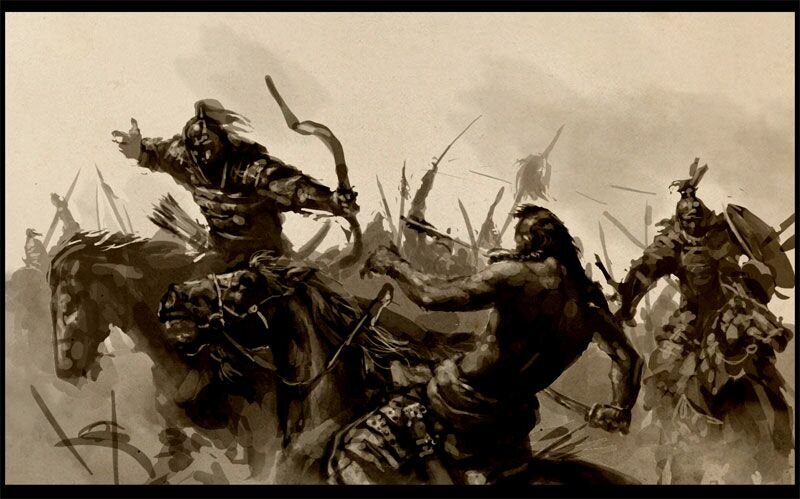 Badamkhand kicks ass. I’ve stated elsewhere that Eastern European artists have stolen a march or two on their Western counterparts, crafting works of art with true fire, blood and steel mixed in with the paint and pixels. The same can be said of Badamkhand and some other Central Asian artists. There is a power inherent in living amid seas of grass astride a spirited horse.. One can see it in art from Vasnetsov to Remington. In the case of Ganbat, that tradition is an unbroken line going back for millennia.
Badamkhand kicks ass. I’ve stated elsewhere that Eastern European artists have stolen a march or two on their Western counterparts, crafting works of art with true fire, blood and steel mixed in with the paint and pixels. The same can be said of Badamkhand and some other Central Asian artists. There is a power inherent in living amid seas of grass astride a spirited horse.. One can see it in art from Vasnetsov to Remington. In the case of Ganbat, that tradition is an unbroken line going back for millennia.
D&D (Sacnoth’s Scriptorium): Setting aside the many borrowings from THE 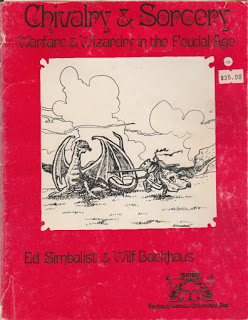 HOBBIT and THE LORD OF THE RINGS in D&D, there’s also evidence that Tolkien’s short work FARMER GILES OF HAM (1949) influenced D&D. In a way this shd not be surprising — in fact, I cd make a case that in plot FGH is more like a D&D adventure than either of Tolkien’s major works available at the time. I think the borrowing has gone unnoticed because it’s art, not text. Here’s a picture by Pauline Baynes of Tolkien’s reluctant hero chasing a dragon (FGH page 44).
HOBBIT and THE LORD OF THE RINGS in D&D, there’s also evidence that Tolkien’s short work FARMER GILES OF HAM (1949) influenced D&D. In a way this shd not be surprising — in fact, I cd make a case that in plot FGH is more like a D&D adventure than either of Tolkien’s major works available at the time. I think the borrowing has gone unnoticed because it’s art, not text. Here’s a picture by Pauline Baynes of Tolkien’s reluctant hero chasing a dragon (FGH page 44).
Games (The Wert Zone): Hero Quest is a board game franchise that was 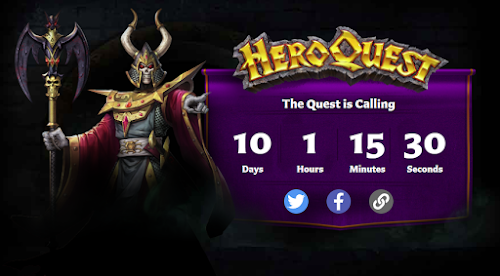 created in 1989 by Milton Bradley Games in collaboration with Games Workshop, who provided the game’s excellent miniatures. The game was set in a traditional fantasy world and saw up to four players create an adventuring party and enter a dungeon, which was laid out and prepared by another player serving as the Games Master. The game used a clever modular board design to provide for hundreds of possible dungeon layouts without spilling over an entire desk (something modern board games sometimes struggle with), and it was possible to play the dungeon adventures as stand-alone quests or sequentially to form a long-running campaign.
created in 1989 by Milton Bradley Games in collaboration with Games Workshop, who provided the game’s excellent miniatures. The game was set in a traditional fantasy world and saw up to four players create an adventuring party and enter a dungeon, which was laid out and prepared by another player serving as the Games Master. The game used a clever modular board design to provide for hundreds of possible dungeon layouts without spilling over an entire desk (something modern board games sometimes struggle with), and it was possible to play the dungeon adventures as stand-alone quests or sequentially to form a long-running campaign.
Science Fiction (Amatopia): The imaginative worldbuilding, deep philosophical contemplation, and pulse-pounding action we’ve come to expect of this series is all here in Endymion, but I have to give a special shout-out to Simmons’s putative villain, Father Captain de Soya. The word “masterpiece” gets thrown around quite liberally, but three books into the Hyperion Cantos and I already feel safe using the term to describe it. Everything I look for in sci-fi is here, and the fact that Simmons’s prose is fantastic is the icing on the cake.
D&D (Goodman Games): Like many my age, I was introduced to roleplaying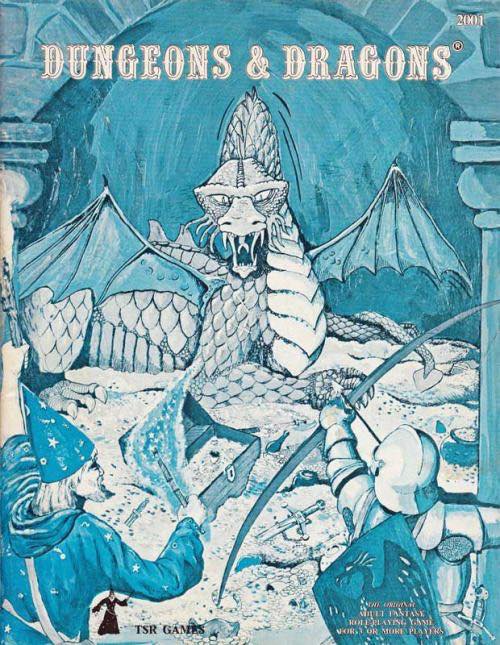 games through the Dungeons & Dragons Basic Set whose rulebook was edited by Dr. J. Eric Holmes. Upon reading it, I was immediately enthralled and soon acquired the Monster Manual, the first of many TSR products that I would seek out over the weeks and months to come. What most of these later purchases had in common is that they proudly bore the byline of Gary Gygax on their covers, their spines, and/or their title pages. Being young and wholly ignorant of the history of this strange new hobby I was undertaking.
games through the Dungeons & Dragons Basic Set whose rulebook was edited by Dr. J. Eric Holmes. Upon reading it, I was immediately enthralled and soon acquired the Monster Manual, the first of many TSR products that I would seek out over the weeks and months to come. What most of these later purchases had in common is that they proudly bore the byline of Gary Gygax on their covers, their spines, and/or their title pages. Being young and wholly ignorant of the history of this strange new hobby I was undertaking.
Fiction (British Fantasy Society): In a world where a pandemic is shaping 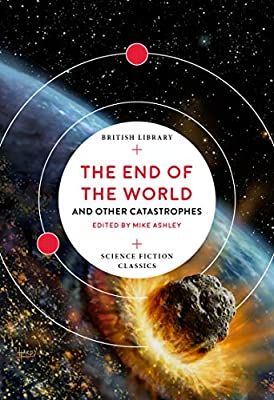 everyday lives, perhaps the SF/Fantasy community is best placed to cope with both the new strictures on our lives and the incompetence of those supposedly controlling it. Disasters on a global scale have long been staple fodder for writers. Stephen King’s The Stand and Richard Matheson’s I Am Legend take the idea of a pandemic wiping out most of humanity. In other books, such as Jim Crace’s Pesthouse, disease as the cause of the disaster is only implied. Disease though only is not the only catastrophe that authors have explored. Trevor Hoyle’s The Last Gasp has a scientifically reasonable scenario for oxygen depletion heralding the end of humanity. These are all novels but many short stories speculate on the issue.
everyday lives, perhaps the SF/Fantasy community is best placed to cope with both the new strictures on our lives and the incompetence of those supposedly controlling it. Disasters on a global scale have long been staple fodder for writers. Stephen King’s The Stand and Richard Matheson’s I Am Legend take the idea of a pandemic wiping out most of humanity. In other books, such as Jim Crace’s Pesthouse, disease as the cause of the disaster is only implied. Disease though only is not the only catastrophe that authors have explored. Trevor Hoyle’s The Last Gasp has a scientifically reasonable scenario for oxygen depletion heralding the end of humanity. These are all novels but many short stories speculate on the issue.
T.V. (Amatopia): The show is well-acted, the costumes and settings are fantastic, and it’s bery dramatic. Like, every single scene is fraught with tension and really intense music. There are fights, though none too bloody despite the show being nicknamed “The Turkish Game of Thrones.” There is also no sex or nudity, perhaps owing to Turkey’s strong Islamic identity which is still a huge influence despite generations of Kemalist attempts to secularize Turkey.
Cinema (Other Master Cylinder): This film is set in a post-apocalyptic wasteland where few fertile men and women exist due to atomic fallout. As a result, the government places a high priority on those that can still breed. Shortly before the movie opens, a group of mutant amphibians (who have been exiled to the desert by humans) capture a group of fertile women and are using them as sex slaves.
Fiction (DMR Books): The desire to talk about Imaro: The Naama War by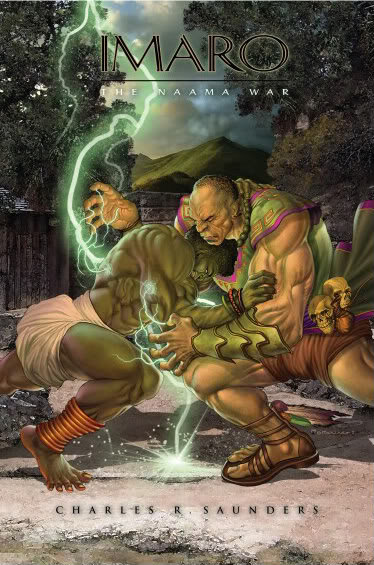 Charles R. Saunders came about because, sure, most everyone knows about the trilogy of Imaro books published by DAW, but how many folks knew he finished the Imaro epic? He did, but it probably didn’t turn up in your local bookstore. This book is only available through Lulu.com. I had my reservations, and they were proven unfounded. Lulu makes a nice paperback.
Charles R. Saunders came about because, sure, most everyone knows about the trilogy of Imaro books published by DAW, but how many folks knew he finished the Imaro epic? He did, but it probably didn’t turn up in your local bookstore. This book is only available through Lulu.com. I had my reservations, and they were proven unfounded. Lulu makes a nice paperback.
Tolkien (Notion Club Papers): That Tolkien was averse to the French Language, and indeed things French in general (especially food), is a frequent theme; after which the various biographers and interpreters try to suggest some specific reason why this should be the case: why Tolkien should have developed such an extraordinary characteristic… But there is no specific reason necessary, beyond that Tolkien was a normal, patriotic Englishman; among whom such an aversion is normal and unremarkable.
Fiction (John C. Wright): Hans G. Schantz’ THE HIDDEN TRUTH is most 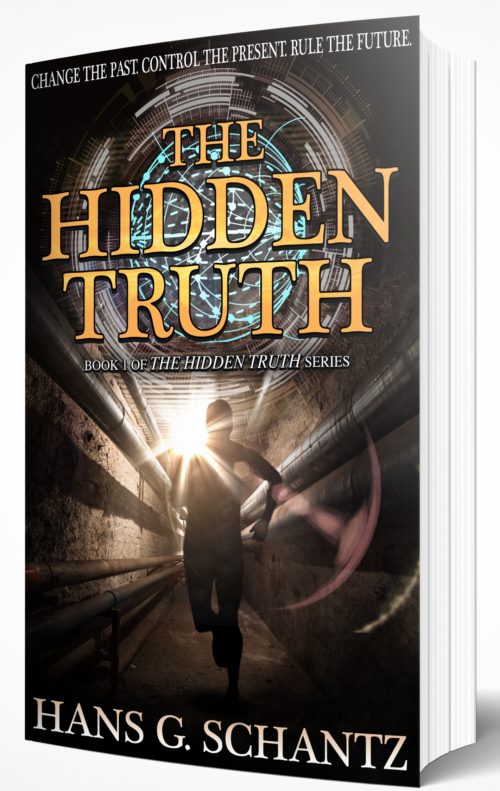 highly recommended. It is a gem of a book, a rare find, combining a charming coming of age story, diamond-hard science fiction speculation, a conspiracy thriller, a touch of trenchant political commentary, and, uniquely, a challenge written into a science fiction book of the reigning scientific orthodoxy of the day. Rarely are science fiction stories written by credentialed scientists.
highly recommended. It is a gem of a book, a rare find, combining a charming coming of age story, diamond-hard science fiction speculation, a conspiracy thriller, a touch of trenchant political commentary, and, uniquely, a challenge written into a science fiction book of the reigning scientific orthodoxy of the day. Rarely are science fiction stories written by credentialed scientists.
RPG (Grognardia): The foreword to the original 1978 edition of Gamma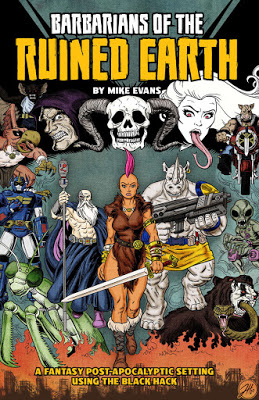 World cites the three books as its inspirations: Brian Aldiss’s The Long Afternoon of Earth, Andre Norton’s Star Man’s Son, and Sterling Lanier’s Hiero’s Journey. The foreword also names a single movie, Ralph Bakshi’s trippy 1977 cult classic, Wizards.
World cites the three books as its inspirations: Brian Aldiss’s The Long Afternoon of Earth, Andre Norton’s Star Man’s Son, and Sterling Lanier’s Hiero’s Journey. The foreword also names a single movie, Ralph Bakshi’s trippy 1977 cult classic, Wizards.
History (Chantireviews): Welcome to the Outremer, where fealties are solemn, rivalries deadly, and intrigue is served up daily along with the wine. Here, well-connected women are worth their weight in gold, and the rules of primogeniture, along with the whims of a king or mandates from the Church can determine a person’s fate. In Balian d’Ibelin: Knight of Jerusalem (Book 1 of the Jerusalem Trilogy), Helena P. Schrader has re-created people, places, and events in the latter 12th-century kingdom of Jerusalem for the reader’s edification and enjoyment.
Cinema (Scifi Scribe): I finally broke down and watched Terminator: Dark Fate. When the project had been originally announced, I was excited on several fronts. First, we had the return of Sarah Connor and the T-800 – both looking much older than the last time we’d seen them together on screen in 1991 (Yes, I know about Genysis but I’m talking the original Sarah played by Linda Hamilton). Secondly, the franchise was rebooting the proper way – or so it seemed – erasing from canon the movies that followed T2 in 1991.
Fiction (George Kelley): Skin Game is a caper novel disguised as an Urban Fantasy adventure. Harry Dresden, Wizard and Winter Knight, finds himself part of a team whose goal is to loot the seventh Vault of Hades (yes, that Hades). Led by the Dresden’s evil enemy Nicodemus Archleone and his demon-possessed daughter, the group includes a shapeshifter, a Sasquatch, a pyromancer, and a safe-cracker.
Fiction (Fantasy Literature): But if a certain novel of 25 years earlier can be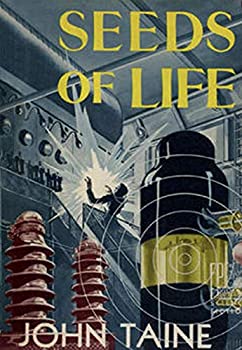 believed, this was not the first time that a human being was subjected to a massive dose of juice, and with astonishing results. The book in question was Scottish-American author John Taine’s ninth novel, Seeds of Life, which features not only one scientist suffering from the side effects of a 2 million-volt exposure, but another who is changed radically in consequence of a 20 million-volt jolt! But more on this in a moment.
believed, this was not the first time that a human being was subjected to a massive dose of juice, and with astonishing results. The book in question was Scottish-American author John Taine’s ninth novel, Seeds of Life, which features not only one scientist suffering from the side effects of a 2 million-volt exposure, but another who is changed radically in consequence of a 20 million-volt jolt! But more on this in a moment.
Art (Heavy Metal): Fantasy artist Ken Kelly isn’t “the Micronauts guy” — that’s not his claim to fame. He’s known for his covers of Warren magazines Creepy, Eerie, and Famous Monsters of Filmland, as well as for album covers for Kiss and Manowar. He’s also a two-time Heavy Metal cover artist, for the November 2005 issue as well as issue 284. But in 1979, with a few years of Warren art (and Kiss’ Destroyer) under his belt, Kelly got a job that was a little odd even in the context of his swords-and-sorcery, vampires-and-werewolves career. The assignment was to do packaging art for the Micronauts line of toys by Japanese manufacturer Mego. Kelly created eight paintings depicting the 4″ action figures in dramatic battle scenes.
Thanks for the signal boost!